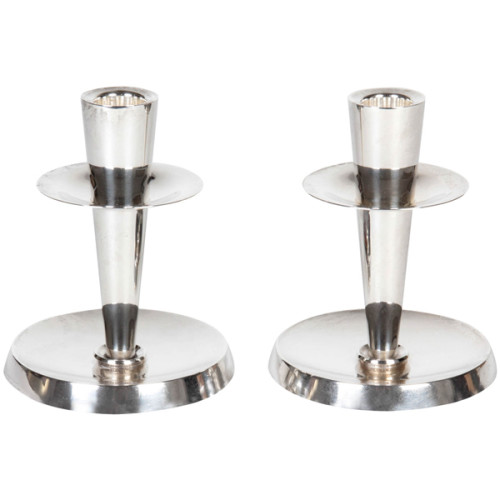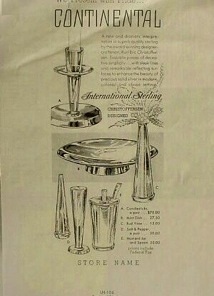Product Description
International Silver Company / Kurt Eric Christoffersen Sterling “Continental” candlesticks c.1955



KURT ERIC CHRISTOFFERSEN (1926-1981) Denmark
INTERNATIONAL SILVER COMPANY Meriden, CT
Pair of Continental candlesticks c.1955
Sterling silver
Marks: INTERNATIONAL STERLING / Christoffersen Designed / CV200
Illustrated: International Sterling Crafts Associates
These candlesticks are illustrated in a vintage ad from the mid-1950’s and were priced at $70 for the pair!
H: 5″ x Dia: 4″
Price: $3,500
Born in Ringsted, Denmark, Kurt Eric Christoffersen graduated from the Academy of Arts and Crafts in Copenhagen. The gifted young craftsman apprenticed with the Copenhagen fir m of Petersen & Lassen, Goldsmiths, before training under the aegis of A. Michelsen, jewelers to the Royal House of Denmark. In 1949, Christoffersen received the Silver Medal for Excellence, the highest award given by the Danish Gold and Silversmiths Guild. Christoffersen began designing for International Silver Co. in 1955.
International Silver Company / Kurt Eric Christoffersen Sterling “Continental” candlesticks c.1955
EDUARD STELLMACHER (designer) Turn-Teplitz, Austria
RIESSNER, STELLMACHER & KESSEL Turn-Teplitz, Austria
AMPHORA ART POTTERY Turn-Teplitz, Austria
Ewer c. 1900
Glazed porcelain
Marks: RStK MADE IN AUSTRIA Turn-Teplitz Bohemia, AMPHORA (in oval), 16, 531
For more information see: Deutsche Kunst und Dekoration, ( March 1901) pp. 346-349; Sammlung Bröhan: Kunsthandwerk, Glas, Holz, Keramik, Vol. 1 Band II (Berlin: Bröhan Museum, 1976), pp. 284-293.
H: 9″ x W: 7 1/2″ x D: 7″
